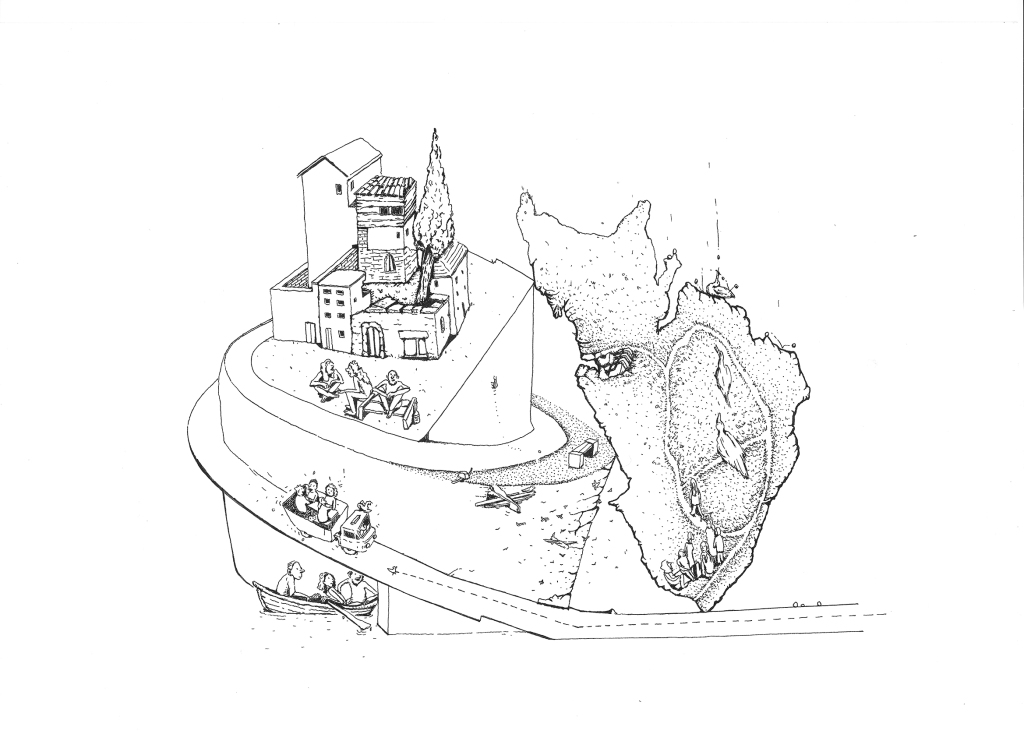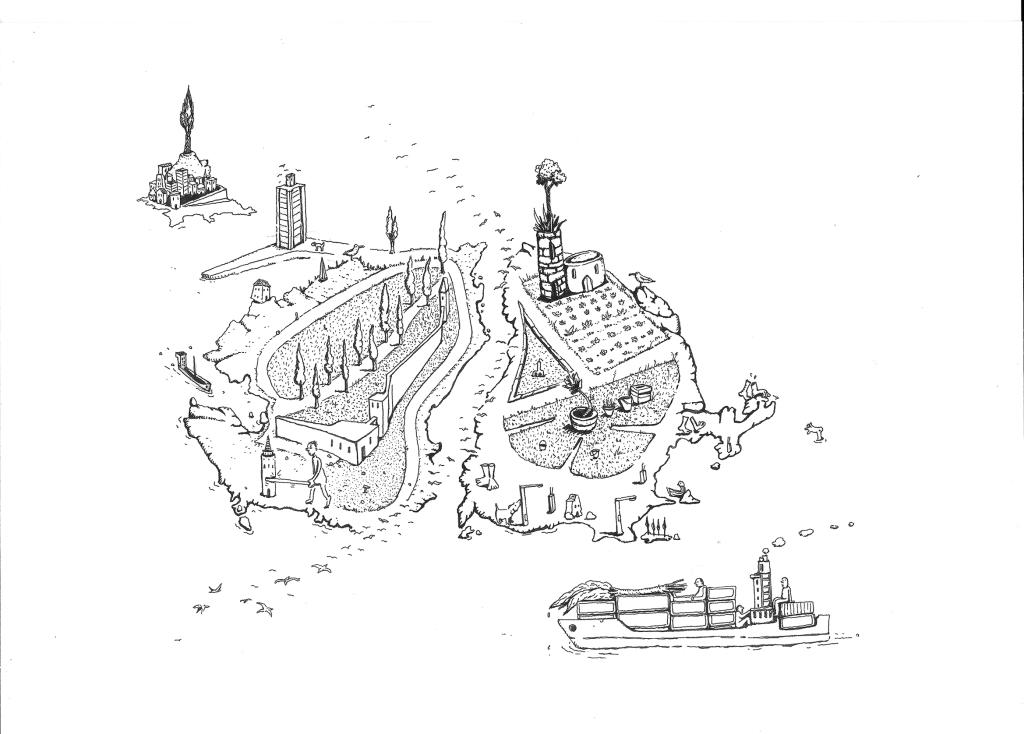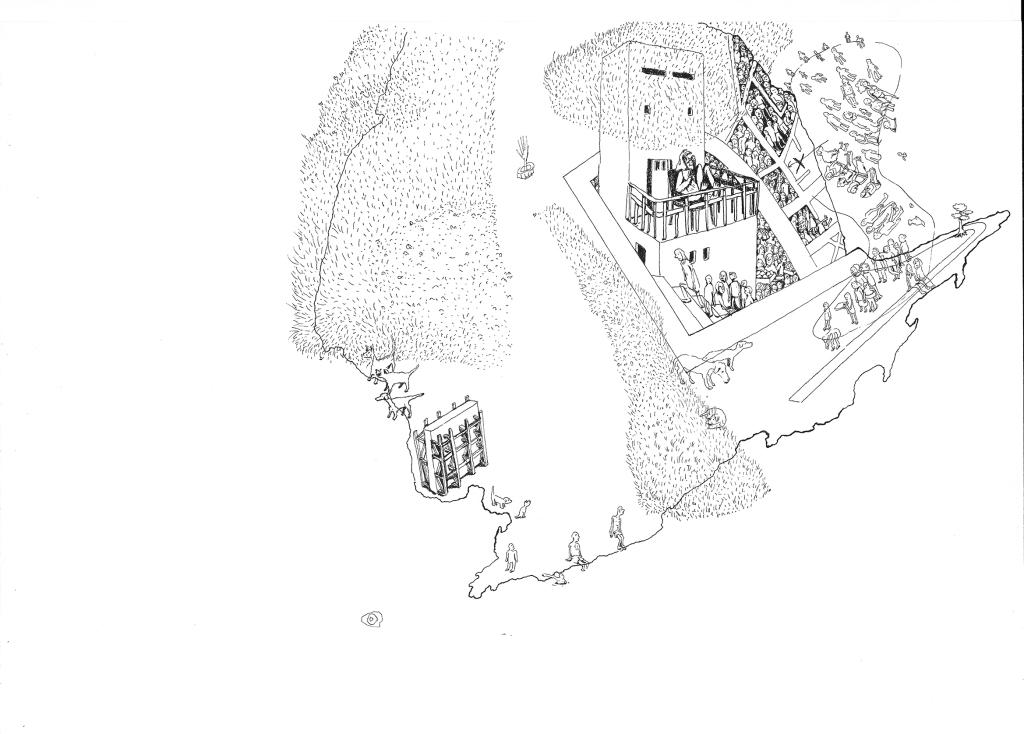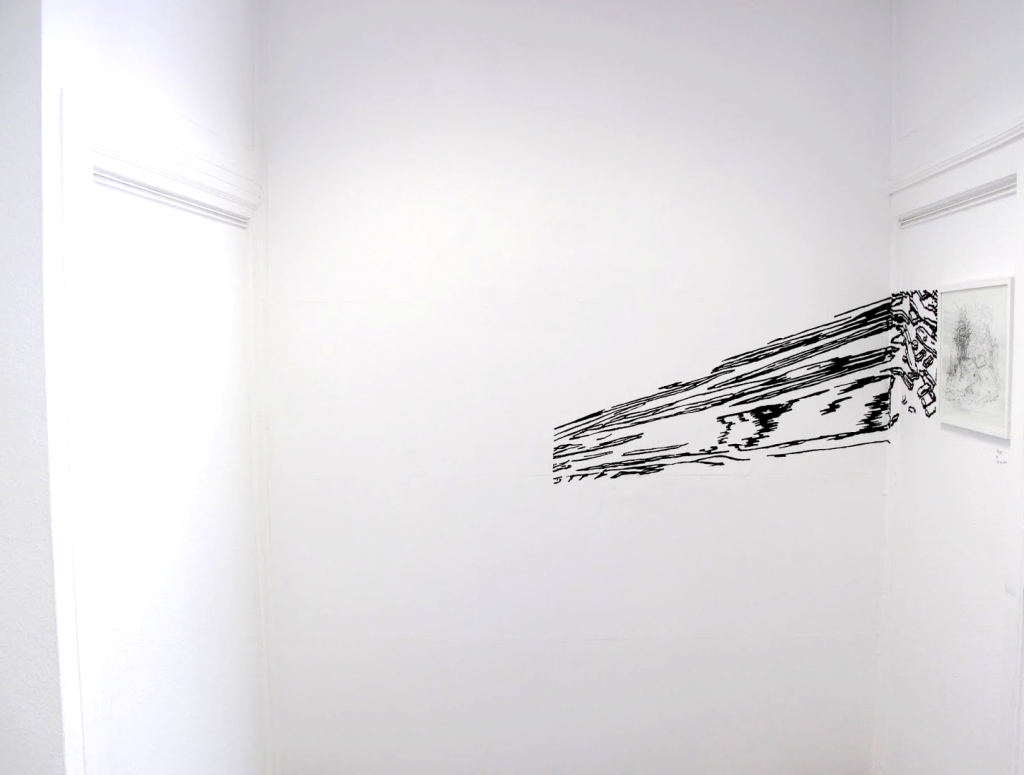Solo exhibition, gallery x-ist, Istanbul, 08/09-10/10-2015
*
*
Tarlada Yüzenler/Swimmers in the Field (26.5×19 cm) and Tsunami (26×29.5 cm), photogravure, , 2010
*
Ceren Oykut’s exhibition Swimmers in the Field originates from her two earlier etchings. First etching takes its inspiration from an early memory of Oykut, the demolishment of a vegetable garden as a part of an urban gentrification project. The namesake etching Swimmers in the Field dates back to 2010 and was created by superposing two images using photogravure technique.
The other work that forms basis to the exhibition is Tsunami. The etching is a detail from a collection of drawings that depicts habitants’ tormenting anticipation of the massive earthquake. In her exhibition, Ceren Oykut gathers fantasy stories by focusing on relationships, past and present attractions that take place both above and below on the unstable and hectic ground she saw, watched and walked on for years.
*
view from the exhibition Tarlada Yüzenler (Swimmers In The Field), acrylic on wall, four framed drawings (ink on paper, 28x38cm) x-ist, 2016, Istanbul Photography: Mesut Güvenli
*
*

*
*
WE, FROM THE FIELDS* / Zafer Aracagök
If Ceren Oykut means, ‘the line’, that is the line’s flow from the paper’s edges towards the walls, that is, the line’s transgression of the surface of the pictorial space towards our living spaces so as to appropriate the contours of our damaged lives and, consequently, its return to the paper, then, we can infer that the scene of slitting of an eye conversed upon in that historical meeting between Bunuel and Dali becomes in Ceren’s works something more than a dream, beyond the displacement of meaning yet in an absolute belonging to here and now, whereby our eyes are slit open to a world in which the meaning pulsates incessantly without even becoming a line. Therefore the space we are invited to by Ceren is not a dream world where the production of meaning is continuously deferred via shifting of one dream content over the other which we can only pretend to have analysed by means of a fortune teller or a book on interpretation of dreams. It is actually contained in the title: this is a space constituted by the Swimmers in the Field. Yet, wait a second, don’t be reminded immediately of some paradoxical situations as in Kafka’s stories, for example, the one in ‘The Great Swimmer’ where the great swimmer does not even know how to swim. Or, the one in ‘Josephine the Singer’ where the mice- nation-wide-famous singer Josephine does not know whether she sings or not. The situation is similar but not quite the same.
Some of you might remember that Ceren sowed the seeds of her first lines on the wooden floors of a building soon to be torn down due to the damages inflicted upon it during a subway construction. That building was demolished long time ago, and its ruins remaining so many years in that colossal field that we call Istanbul have risen in a new form now in the midst of the city. Meanwhile, Ceren’s seeds sown together with these ruins kept coming back to life in new and different forms all throughout these years. Yet, still, we do not need a metaphor here as I am talking about an event with ultimately objective, political, sociological and historical parameters so that we do not need to sigh and despair with nostalgic and self-pitiful remarks: ‘Oh Istanbul, the great Istanbul, what happened to you!’ In fact, seeds similar to Ceren’s have always been sown in these lands by people like Abidin Dino, Cihat Burak, Aliye Berger, and Byzantinian icon painters. This is a field where lines swim around without sinking yet with roots reaching far down in the bottoms ⎯ call them rhizomes, if you like, or radicles, but this is a field that is comprised of a particular swimming style in which are blended together all the possible and compossible lines encapsulated within various seeds of different shapes and colours. Therefore, the swimmers of this field are not contained in a linear historical line, they do not que up in a line of tradition, yet they exist in as much as they continue to swim.
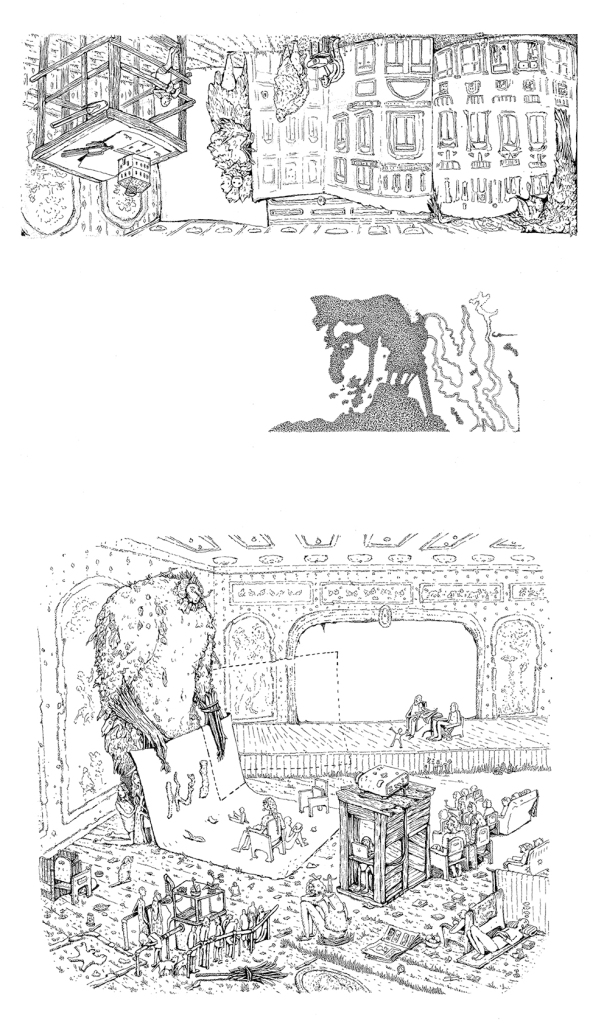
Who are the swimmers of this field? Or, who are the figures of this swimming style? Before all, there is a gorilla. Actually, we are all familiar with this gorilla. He came alive during Gezi, we all strolled together by Emek Movie Theatre, Gezi Park, in Istiklal Street, threw projections on non-existent walls, and opened up new paths to becoming-animal. Ceren’s gorilla with straight- inbetween-reversed layers not only enables us to establish ties with the uncertain figures of the coffee-cup fortune telling that stretch forth to future but he also points out at the fact that this future already exists right here and right now ⎯ if only our belief in society as vertigo is strong enough.
Then, Hazzopulo Passage joins the list of the swimmers in the field with an economy of line, which, starting in 1871, looks as if always and already interrupted in the fractured and broken tiles of the entrance, disturbing the human/space proportions. Do things sleep at night? Or do they become the unconscious of a sleeper suffering from ‘Alice Syndrome’? Our gorilla, all throughout day and night or night and day, that is, without any concern for the order as long as they are in a completely obtuse and reversed relationship waits for the hat he has ordered at Madamme Katia’s. The Lilliputians having invaded the passage walk around pellmell or fast asleep in chairs as if to underline the impossibility of connecting the unconscious tunnels of the city then and now ⎯ even after the countless attacks of annihilating Istanbul ⎯ reminding us the great work of Walter Benjamin. As we have attempted to adumbarate before, narrative is not rejected in Ceren’s works, moreover, on the level of the figural, there’s a desire for telling a story; however, without falling into the dichotomy of abstract/concrete, it turns into an act of remembering which does not long for being organised ⎯ a free association of both our minds and the unconscious. For example, we do not yearn for Markiz or Lebon but we start hearing Ahmet Hamdi Tanpınar’s Mahur Beste which disintegrates or mellows down to its constitutive elements after a cheerful and allegro introduction.
Without doubt, the line does not progress always the same way. Sometimes, as in Rüya 3 (Dream 3), the line cannot contain itself and brims over this aforementioned desire. At such instances, the line, running helter-skelter as in the cry of a seagull, or as in the atopological buzzing of a fly (what is unnerving in the flight of a fly is not the possibility of being stung at any moment what so ever but its uncanny, directionless and unpredictable movement almost without coordinates) destroys the figural order by addressing the eye and the ear at the same time. Why do I get dizzy now? Am I face to face with a case of tinnitus right now? Have I started hallucinating voices? All is possible yet what is more important is this foregrounding of a routeless map, the possibility of being led astray, the line’s capacity of leading the observer astray. In other words, the juncture where even the line of escape escapes from itself.
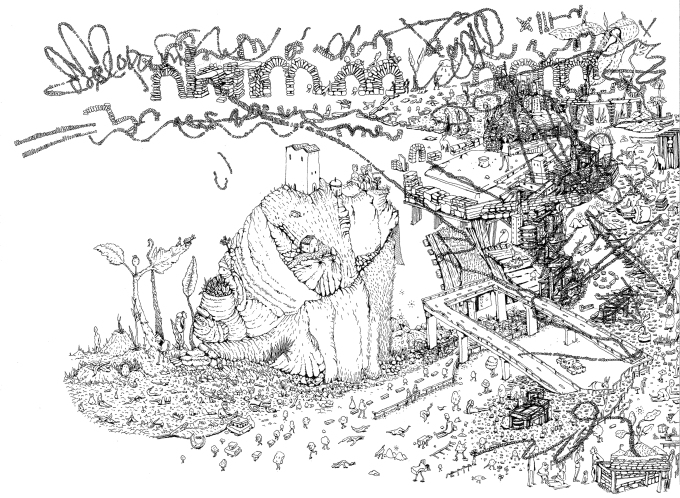
Sometimes, the lines of escape build up an harmony with the lines from which they escape, thus coronating the state of escape. For example, sometimes, they turn into an immensely limitless field of Istanbul where entries and exits cannot be controlled, giving the lie to the concept of control itself. Economy does not exist here. In other words, here’s a field where you cannot buy even a lemon although you can ask for the price of a lemon. Not even exchange exists here. There are only interminglings and overlappings ⎯ cheerful yet a field full of overwhelming risks. Thus, the flames of Istanbul Kavurma (Istanbul Roast), instead of absorbing us into its depths, opens up a space between us and itself, and, failing to cover this space up instantly with our eyes, we realise only too late that the focal point of this roast is located at a place far behind us. As if to remind us the techniques of the Byzantinian icon painters, the optical space we thought to have opened up before our eyes starts to contain even us and only when what is presented moves beyond our backs, and having gathered all the lines surrounding us, it returns to the space of painting we envisage: We are also the swimmers in this field.
Temmuz 2015 Galata
*The text written by Zafer Aracagök for the catalog of the exhibition titled Swimmers In The Field, published by x-ist, 750 copies
.
*
Ücra (Remote), drawing series, 21×29.5, ink on paper, 2014
*
*
BİZ, TARLALILAR* / Zafer Aracagök
Ceren Oykut demek ‘çizgi’ demekse ve çizginin kağıtları aşarak duvarlara uzanışı, yani, çizginin resmin kağıtsal uzamını ihlal edip yaşadığımız uzamlara akarak buradaki zedelenmelerin konturlarını özümsemesi ardından aldığı hasarlarla tekrar kağıda dönüşüyse, o tarihsel Bunuel ve Dali buluşmasında sözedilen göz çizme sahnesinin Ceren’in işlerinde rüyadan da öte, yani anlam kaymalarından da öte ama bir o kadar da buraya ait, anlamın henüz bir çizgi bile oluşturmadan sürekli titreşip durduğu bir dünyaya gözlerimizi çizdiğini söyleyebiliriz. Öyleyse bir rüya değil Ceren’in bizi davet ettiği alan, bir anlamın öteki üstünden kayarak anlam üretiminin sürekli ertelendiği, ancak ve ancak bir rüya tabirleri kitabı ya da falcı aracılığıyla çözümlemiş gibi yapabileceğimiz bir alan değil. Aslında adı üstünde burası Tarlada Yüzenler’den oluşan bir alan. Bir dakika, aklınıza hemen Kafka’nın öykülerinde, örneğin yüzmesini bilmeyen ‘Yüzme Şampiyonu’nda olduğu gibi paradoksal bir durum gelmesin. Ya da şarkı söylemesini bilmeyen o ünlü ‘Şarkıcı Josephine’deki gibi değil durum. Benziyor ama tam da öyle değil.

Hatırlayanlar bilir Ceren ilk çizgilerini metro inşaatı yüzünden hasar gördüğü için yıkılacak olan bir apartmanın ahşap döşemelerine ekmişti. O bina çoktan yıkıldı, yıllar boyunca İstanbul dediğimiz o kocaman tarlanın içinde gömülü kaldı ve ardından tekrar yükseldi. Bütün bunlar olurken aradan yıllar geçti ve zaman içinde tarlaya ekilen tohumlar başka başka formlar halinde sürekli karşımıza çıktı. Durun, durun, burada hiç metafora ihtiyacımız yok, son derece nesnel, siyasi, sosyolojik, tarihsel parametreleri olan bir olaydan bahsediyorum ve öyleyse hiç de nostaljik bir havaya kapılarak, ah İstanbul vah İstanbul dememize gerek yok. Aslında Ceren’in ektiğine benzer tohumlar bu coğrafyada hep ekildi, kimler geldi kimler geçmedi bu topraklardan. Ne Abidin Dino’lar ne Cihat Burak’lar, ne Şeker Ahmet Paşa’lar ne Bizanslı ikonacılar. İşte bu hala batmadan su yüzünde kalarak ama kökleri de bir o kadar derinlere giden çizgilerin yüzdüğü bir tarla bu, dilerseniz rizomatik kökler deyin, dilerseniz köksapların yüzdüğü bir tarla ama işte irili ufaklı her türlü tohumun, tohum denen şeyin barındırdığı çizgiselliklerin harmanlandığı bir yüzme stilinden oluşan bir tarla. O yüzden lineer bir tarihte yer almıyor bu yüzücüler, gelenek kuyruğuna girmiyorlar ama sadece tarlada yüzdükleri kadar varlar.
Kimler var bu yüzücüler arasında? Ya da kimler bu yüzme stilinin figürleri? Ama en başta bir goril var. Hepimiz tanıyoruz aslında bu gorili. Gezi’de canlanmıştı, gerek Emek Sineması, gerek Gezi Parkı, gerekse İstiklal’i hep birlikte arşınlamış, olmayan duvarlara projeksiyonlar yapıp, hayvan-oluş’a geri dönüşün yollarını açmıştık. Ve Ceren’in gorili kahve falının geleceğe uzanan müphem figürleriyle ilişki kurmamızı sağlamakla kalmıyor, düz-ara-ters katmanlarıyla, bu geleceğin aslında tam da şu anda varolduğuna işaret ediyor eğer toplum denen şeyin bir vertigo olduğuna inancımız sağlamsa.

Hazzopulo Pasajı da ekleniyor tarlada yüzenler listesine bilhassa 1871’de başlamış bir çizgi ekonomisinin henüz daha pasajın girişinde kırık çatlak yer karolarında kesintilere uğrayıp insan mekan orantılarını bozarak. Geceleri eşyalar uyur mu? Yoksa, Alice Sendromu’ndan müzdarip bir uykucunun bilinçaltına mı dönüşürler? Gorilimiz gece-gündüz ya da gündüz-gece ama birbiriyle yine tersten taban tabana zıt bağlantı içinde Madam Katia’ya bir şapka siparişi vermiş beklemektedir. Lilliput sakinleri pasajı işgal etmiş, kah sallana sallana yürüyüp kah sandalye köşelerinde uyuklarken, Walter Benjamin’in Paris pasajlarını anımsatacak şekilde kentin bilinçaltı tünellerini birbirine bağlamanın gerek o dönemlerde gerekse günümüzde bunca yoksayma taarruzları geçirdikten sonra hemen her zaman imkansız olmuş olduğunun altını çizmektedir sanki. Daha önce ima etmeye çalıştığımız gibi, Ceren’in işlerinde belki bir anlatı reddedilmiyor, hatta figürsellik bağlamında, tam da bir hikaye peşinde koşuluyor ama bu çaba soyut/somut karşıtlığından da öte, organize olmayı özlemeyen belleklerimizin özgürce hatırlama eylemine dönüşüyor. Örneğin, ah Markiz, ah Lebon demiyoruz ama Ahmet Hamdi Tanpınar’ın Mahur Beste‘sini duyuyoruz, neşeli bir giriş taksiminden sonra gitgide ağırlaşan ve notalarına çözülen.
Kuşkusuz her zaman böyle olmuyor. Bazı zamanlar, Rüya 3‘de olduğu gibi çizginin kendini ihtiva edemediği, taşkınlığa ulaştığı zamanlar da oluyor. Burada çizgi adeta çığlık çığlığa bir martı ya da rotası belirlenemeyen bir sivrisineğin vızıldayışı gibi (ki sinir bozucu olan aslında sineğin bizi sokması değil, tekinsiz, yönsüz, koordinat-dışı uçuşudur) göze ve kulağa aynı anda hitap ederek figürsel düzlemi altüst ediyor. Eh peki şimdi niye başım dönüyor? Bir ‘tinnitus’ vakasıyla mı karşı karşıyayım? Olmayan sesleri mi duymaya başladım? diye soruyor insan. Evet belki öyle ama bundan da önemlisi, bir rüyadaki çizginin yol haritasızlığı ve her an yoldan çıkma, yoldan çıkarabilme özelliği. Bir başka deyişle, kaçış çizgisinin bile kendinden kaçtığı nokta.

Bazı zamanlarsa, kaçış çizgileri kaçtıkları çizgilerle birlikte bir armoni oluşturup kaçışı taçlandırıyorlar. Örneğin, giriş ve çıkışların asla kontrol edilemeyeceği, adeta kontrol kavramını silmek için varolan uçsuz bucaksız bir İstanbul tarlasına dönüşüyorlar. Ekonomi yok burada. Yani limon kaça diye sorsanız bile limon alamayacağınız bir tarla. Değiş tokuş bile yok. Sadece içiçe geçme ve üstüste binme var neşeli ama bir o kadar da aşırı risklerle dolu bir tarla. İstanbul Kavurma‘nın ateşi bizi böylece derinliklerine çekmek yerine, önümüze, kendisiyle izleyici arasında açılan bir alan sunuyor ve gözlerimizle çok kolay konsantre olamadığımız bu kavurmanın odak noktasının arkamızda bir yerlerde yeraldığını ancak çok sonra farkedebiliyoruz. Bizanslı ikonacıların tekniğini hatırlatırcasına gözlerimiz önüne sunulduğunu sandığımız optik alan aslında bizleri de kapsayıp arkamıza geçiyor ve sunulan şey etrafımızı sarıp sarmalayan çizgilerle birlikte ancak resmin uzamına geri dönünce farkedebiliyoruz: Biz de bu Tarla’nın yüzücülerindeniz.
Temmuz 2015, Galata
*Zafer Aracagök’ün x-ist tarafından 750 adet basılan Tarlada Yüzenler sergi kataloğu için yazdığı metin
*
*
Swimmers In The Field at 17. Internationaler Comic-Salon Erlangen,
26-29 May 2016
Kunstverein – Neue Galerie, Erlangen, Germany

Swimmers in the Field builds on a series of earlier etchings of Ceren Oykut. The etching titled Swimmers In The Field, go back to a memory of the artists childhood – the destruction of a vegetable garden as part of a gentrification project. In the exhibition Swimmers in the Field the artist collects fantastic stories and always keeps an eye on the connections and relationships between people and the surrounding. In doing so, Ceren Oykut does not draw a picture of an urban Turkish society, but rather conveys a comprehensive tableau of a person who is increasingly losing herself in the face of the discontinuity of life and the speed that surrounds her.
An exhibition by the International Comic Salon Erlangen in cooperation with ERBEŞ e. V. – Friends of the city partnership Erlangen-Beşiktaş and with the support of the Kunstverein Erlangen e. V.
*
*
*
*











